Recent Posts
-
And Yet, We Go On
April 22, 2024
-
It IS Happening Here
February 16, 2024
-
General Ludd to General Intellect
January 11, 2024
-
Temporal and Geographic Edges
December 26, 2023
-
The Root of All Evil
October 13, 2023
-
Post-Pandemic Melancholia . . . Same As It Ever Was?
September 3, 2023
-
Chronicle of Deaths Foretold
June 24, 2023
-
Reparations is the Least We Should Do
May 11, 2023
-
We Are Not Alone
April 9, 2023
-
War and Anti-War
February 22, 2023
|
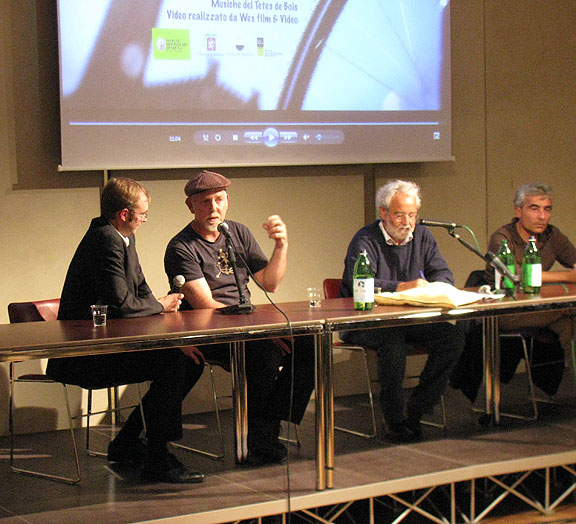 Saturday September 26 Panel: "Bicycling in a Time of Crisis" l-r David Walthall, myself, Claudio Sabelli Fioretti, Tito Boeri. Ediciclo Editore is a relatively small Italian publisher focused on bicycling and travel books. They invited me to their 3rd annual “Ciclomundi Festival Nazional del Viaggio in Bicicletta” (CycleWorld National Festival of Bicycle Travel) Sept. 24-26 in Siena, a fantastically beautiful small city in Tuscany. I had a great time. I had some trepidation before arriving, worrying that I would find myself in a gathering of folks entirely focused on high-end bicycle gear, tourism, etc., but the spirit and tone of the Festival was much broader and quite inclusive. My “gang” from Rome was in the house too, representing a few different DIY bikeshops that have sprung up there in the past few years (ciclofficine is the Italian name). Paolo Rotafixa, with whom I stayed in 2008, shared a Sunday morning panel with me, along with four others, and we were both very impressed by the presentations. He leaned over to me at one point and said it was the best panel he’d ever been on or even heard regarding a bicycle discussion…
The events began on Friday night with a beautiful poetic and musical presentation on the 19th century globe-trotting cyclists who are the direct spiritual ancestors of this Festival’s participants. It was all in Italian which I can only get a small percentage of, but the historic images told a great deal of the story, especially since I wrote about 19th century cycling in San Francisco quite recently. Alberto Fiorin, one of the editors of Ediciclo, was the moderator and conductor who knit together the three eloquent speakers while an accordion, bass, and guitar would strum quietly behind them, occasionally bursting forth into boisterous song to take the lead. (Alberto also met me in Rome and accompanied me to Siena, much to my pleasure and gratitude.)
The Romans had their tallbikes and other zany vehicles, and brought them out throughout the weekend to regale the thousands of tourists gawking at the stunning Duomo from the surrounding piazza. I got to take a spin too, as did Federico, a sharp young journalist with whom I had a stimulating, long interview on Saturday. Here we are taking our turns”¦
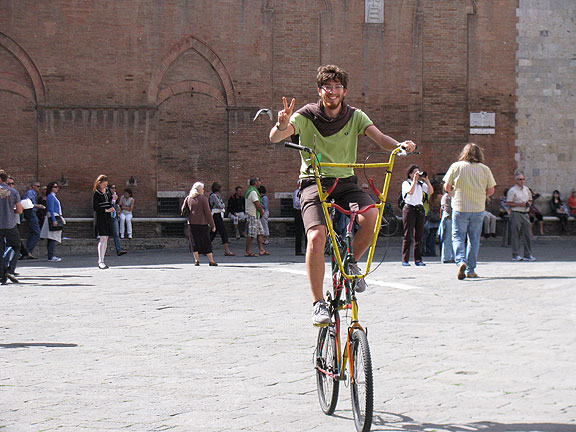 Federico Petroni 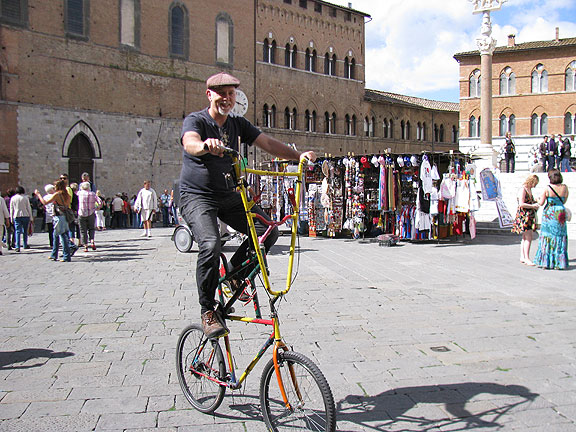 Touring the Piazza del Duomo in Siena the right way! Continue reading Ciclomundi
 Siena prides itself on being descended from the son of Romulus, one of the babies suckling at the she-wolf in the ubiquitous statues around town. This is on the wall near the train station. 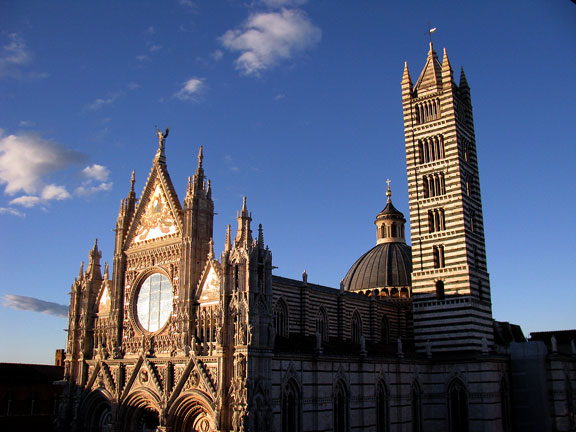 Here's the main cathedral (the Duomo) in Siena, with very late afternoon sun making it glow. 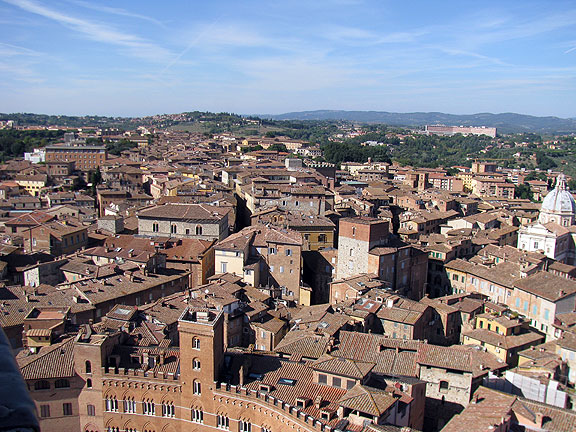 View norhward from Torre La Mangia, overlooking the main plaza, Piazza del Campo. I arrived midday on Thursday before the Ciclomundi Conference started on Friday night. That gave me some hours to try to overcome my horrendous jet-lag, and also to be an unabashed tourist in this stunning Tuscan city, in addition to squeezing in a 40-kilometer ride in the vicinity of Gaiole in Chianti, a small village in that famous wine-making region.
I was in Siena once before, so I knew how incredibly beautiful it is, but having just spent almost four days here I have gained a much greater appreciation for its texture and nuances. One of my favorite things about it, a feature it shares with most cities in this part of Italy, is the way the flow of city life is shaped by the geography on which the city was built. Years ago we published an hilarious article in Processed World called Dear Del Monte but it was also a brilliant piece in the way the author, Mark Leger, wove together the absurdity of working in the complaint department at the big food company with a deeper rumination on land-use, community, family, and eating habits. He explained how ridiculous it was that in California housing was sprawling over prime farm lands, while in a sensible and much older settled place like Tuscany in Italy, the towns were built on the hilltops to leave the farmland open for food production. Sure enough, Siena fits that description perfectly, the centuries-old part of the city sitting atop a series of hills and ridges. Here are some photos of the streets that are far from a grid, but just naturally lead the walker from one plaza to another, along the busy commercial streets. The shops run the gamut from upscale international brands to local cutlery and hat shops, tourist junk to pizza and ice cream”¦ in other words, Siena is pretty normal amidst the stunning architecture and ancient rhythms of urban movement.
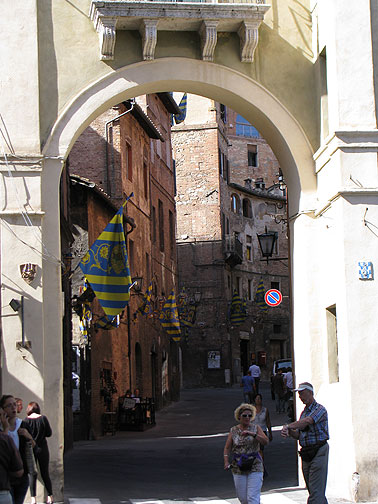 Arches beckon at every turn. Continue reading Siena, A Visible Invisible City!
That’s the title of a piece (pdf) I wrote in 2003 and published in The Political Edge. On this Labor Day, it’s more true than ever. The way we make the world we live in is seriously broken. There’s a lot of work to do, but mostly we’re not doing it. Then there’s a lot of jobs out there that should be abolished and the work stopped tomorrow! We’d be wealthier as humans, and the planet would be healthier immediately too (banking, insurance, advertising, real estate, military production, shoddy commodity manufacturing instead of making things to last 75 years, etc. etc.) The soaring unemployment rates, the crashing economic production figures, the severe ecological crisis (call it climate chaos, global warming, whatever), endless war and widespread famine and thirst”¦ it’s not rocket science to see that things aren’t right.
The most common demand and solution heard from the so-called “Left,” as well as the more populist strains of the Right, is for Jobs! At the recently held Community Congress in San Francisco, representatives of the Living Wage Coalition and Jobs With Justice were among many who put forth the demand for Jobs (albeit with wages that can support people in this expensive city). Local trade unions in the East Bay are clamoring to build the wildly expensive and completely unneeded Oakland Airport Connector because it will create “jobs.” Big Oil and other transnational corporations are on the bandwagon too, having the gall to launch an Astroturf campaign called “Jobs Not Taxes.” The mainstream liberal left, including the AFL-CIO and a number of Democratic politicians are calling for One Nation Working Together at a big mass rally October 2 in Washington DC, which is supposed to “put America back to work,” as though we’re not working all too much doing idiotic things already!
If you are unemployed, or underemployed, and certainly if you’re underpaid as at least a quarter of the working population of the U.S. earning $9/hour or less is (not to mention the rest of the world where it is even worse), the demand for jobs is misguided at best. In a capitalist economy what we need is a livable income, and to get that we need a radical redistribution of wealth. I read a stat recently that the past two decades’ severe skewing of wealth towards the top has led to the situation where 5,600 families in the U.S. have as much wealth as the bottom 138 million people. (An analysis by economists Thomas Piketty and Emmanuel Saez found that despite several periods of healthy growth between 1973 and 2005, the average income of all but the top 10 percent of the income ladder — nine out of ten American families — fell by 11 percent when adjusted for inflation. For three decades, economic growth in the United States has gone first and foremost to building today’s modern Gilded Age. The recipients of those gains don’t care about a fully funded Social Security system or a healthy Medicare program — they don’t need them.)
Obviously having a job and some income is better than abject destitution, but it fails to address the deeper issues we face. For many, the urgency and desperation that unemployed people face requires them to demand jobs. Why not demand income ahead of jobs? I suppose it’s because there’s something acceptable and supposedly “dignified” about “earning” your own living, even if most jobs put people into ridiculous situations of doing pointless, or pernicious, or just bad work, in exchange for inadequate wages and often no benefits.
A recent book, The Moral Underground: How Ordinary Americans Subvert an Unfair Economy by Lisa Dodson, tells heartbreaking stories of people trying to play by the rules, taking low-wage jobs and finding it impossible to make ends meet, especially when their children or elderly parents need care as most do. Dodson interviewed dozens of workers and middle-managers and what she reveals is that at least occasionally there is a well-developed conspiracy to pad workers incomes and reappropriate time and goods, often with the complicity of their front-line bosses (who cannot ethically enforce the rules of the market). It’s fascinating although exasperating too, especially when she’s recounting the interviews with the managers who repeat ad nauseum the casual racism and blame-the-poor mentality that sustains so many self-righteous American attitudes. Overall The Moral Underground dovetails well with Barbara Ehrenreich’s Nickel and Dimed of a few years ago, wherein she tried to live as a low-wage worker and found herself falling further and further into a debt trap.
Continue reading Jobs Don’t Work!
|
|


















